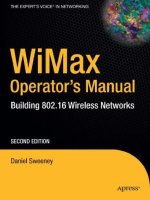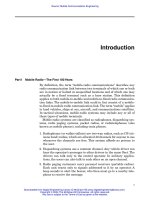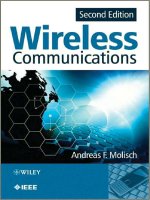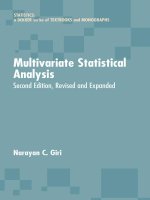.WIRELESS COMMUNICATIONSW ireless Communications, Second Edition Andreas F. Molisch © 2011 John ppsx
Bạn đang xem bản rút gọn của tài liệu. Xem và tải ngay bản đầy đủ của tài liệu tại đây (12.02 MB, 884 trang )
WIRELESS
COMMUNICATIONS
W ireless Communications, Second Edition
Andreas F. Molisch
© 2011 John Wiley & Sons Ltd. ISBN: 978-0-470-74187-0
WIRELESS
COMMUNICATIONS
Second Edition
Andreas F. Molisch, Fellow, IEEE
University of Southern California, USA
A John Wiley and Sons, Ltd., Publication
This edition first published 2011
© 2011 John Wiley & Sons Ltd.
First edition published 2005
Registered office
John Wiley & Sons Ltd, The Atrium, Southern Gate, Chichester, West Sussex, PO19 8SQ, United Kingdom
For details of our global editorial offices, for customer services and for information about how to apply for permission to
reuse the copyright material in this book please see our website at www.wiley.com.
The right of the author to be identified as the author of this work has been asserted in accordance with the Copyright,
Designs and Patents Act 1988.
All rights reserved. No part of this publication may be reproduced, stored in a retrieval system, or transmitted, in any
form or by any means, electronic, mechanical, photocopying, recording or otherwise, except as permitted by the UK
Copyright, Designs and P atents Act 1988, without the prior permission of the publisher.
W iley also publishes its books in a variety of electronic formats. Some content that appears in print may not be available
in electronic books.
Designations used by companies to distinguish their products are often claimed as trademarks. All brand names and
product names used in this book are trade names, service marks, trademarks o r registered trademarks of their respective
owners. The publisher is not associated with any product or vendor mentioned in this book. This publication is designed
to provide accurate and authoritative information in regard to the subject matter covered. It is sold on the understanding
that the publisher is not engaged in rendering professional services. If professional advice or other expert assistance is
required, the services of a competent professional should be sought.
Library of Congress Cataloguing-in-Publication Data
Molisch, Andreas F.
Wireless communications / Andreas F. Molisch. – 2nd ed.
p. cm.
Includes bibliographical references and index.
ISBN 978-0-470-74187-0 (cloth) – ISBN 978-0-470-74186-3 (pbk.)
1. Wireless communication systems–Textbooks. I. Title.
TK5103.2.M65 2011
621.3845’6–dc22
2010017177
A catalogue record for this book is available from the British Library.
Print ISBN: 9780470741870 (H/B)
Print ISBN: 9780470741863 (P/B)
ePDF ISBN: 9780470666692
Typeset in 9/11 Times by Laserwords Private Limited, Chennai, India.
Contents
Preface and Acknowledgements to the Second Edition xxiii
Preface to the First Edition xxv
Acknowledgments to the First Edition xxix
Abbreviations xxxi
Symbols xlvii
Part I INTRODUCTION 1
1 Applications and Requirements of Wireless Services 3
1.1 History 4
1.1.1 How It All Started 4
1.1.2 The First Systems 4
1.1.3 Analog Cellular Systems 5
1.1.4 GSM and the Worldwide Cellular Revolution 6
1.1.5 New Wireless Systems and the Burst of the Bubble 7
1.1.6 Wireless Revival 8
1.2 Types of Services 8
1.2.1 Broadcast 8
1.2.2 Paging 9
1.2.3 Cellular Telephony 10
1.2.4 Trunking Radio 12
1.2.5 Cordless Telephony 12
1.2.6 Wireless Local Area Networks 14
1.2.7 Personal Area Networks 14
1.2.8 Fixed Wireless Access 14
1.2.9 Ad hoc Networks and Sensor Networks 15
1.2.10 Satellite Cellular Communications 16
1.3 Requirements for the Services 16
1.3.1 Data Rate 16
1.3.2 Range and Number of Users 17
1.3.3 Mobility 18
1.3.4 Energy Consumption 19
1.3.5 Use of Spectrum 20
vi Contents
1.3.6 Direction of Transmission 21
1.3.7 Service Quality 21
1.4 Economic and Social Aspects 22
1.4.1 Economic Requirements for Building Wireless Communications Systems 22
1.4.2 The Market for Wireless Communications 23
1.4.3 Behavioral Impact 24
2 Technical Challenges of Wireless Communications 27
2.1 Multipath Propagation 27
2.1.1 Fading 27
2.1.2 Intersymbol Interference 31
2.2 Spectrum Limitations 32
2.2.1 Assigned Frequencies 32
2.2.2 Frequency Reuse in Regulated Spectrum 34
2.2.3 Frequency Reuse in Unregulated Spectrum 35
2.3 Limited Energy 35
2.4 User Mobility 36
3 Noise- and Interference-Limited Systems 37
3.1 Introduction 37
3.2 Noise-Limited Systems 37
3.2.1 Link Budget 40
3.3 Interference-Limited Systems 43
Part II WIRELESS PROPAGATION CHANNELS 45
4 Propagation Mechanisms 47
4.1 Free Space Attenuation 47
4.2 Reflection and Transmission 49
4.2.1 Snell’s Law 49
4.2.2 Reflection and Transmission for Layered Dielectric Structures 51
4.2.3 The d
−4
Power Law 53
4.3 Diffraction 54
4.3.1 Diffraction by a Single Screen or Wedge 55
4.3.2 Diffraction by Multiple Screens 59
4.4 Scattering by Rough Surfaces 63
4.4.1 The Kirchhoff Theory 64
4.4.2 Perturbation Theory 65
4.5 Waveguiding 66
4.6 Appendices: please see companion website (www.wiley.com/go/molisch)67
4.A: Derivation of the d
−4
Law
4.B: Diffraction Coefficients for Diffraction by a Wedge or Cylinder
Further Reading 67
5 Statistical Description of the Wireless Channel 69
5.1 Introduction 69
5.2 The Time-Invariant Two-Path Model 71
5.3 The Time-Variant Two-Path Model 72
5.4 Small-Scale Fading without a Dominant Component 74
Contents vii
5.4.1 A Computer Experiment 75
5.4.2 Mathematical Derivation of the Statistics of Amplitude and Phase 78
5.4.3 Properties of the Rayleigh Distribution 80
5.4.4 Fading Margin for Rayleigh-Distributed Field Strength 82
5.5 Small-Scale Fading with a Dominant Component 83
5.5.1 A Computer Experiment 83
5.5.2 Derivation of the Amplitude and Phase Distribution 83
5.5.3 Nakagami Distribution 87
5.6 Doppler Spectra and Temporal Channel Variations 88
5.6.1 Temporal Variations for Moving MS 88
5.6.2 Temporal Variations in Fixed Wireless Systems 90
5.7 Temporal Dependence of Fading 91
5.7.1 Level Crossing Rate 91
5.7.2 Average Duration of Fades 92
5.7.3 Random Frequency Modulation 94
5.8 Large-Scale Fading 95
5.9 Appendices: please see companion website (www.wiley.com/go/molisch)99
5.A: The Lindeberg–Feller Theorem
5.B: Derivation of the Rayleigh Distribution
5.C: Derivation of the Level Crossing Rate
Further Reading 99
6 Wideband and Directional Channel Characterization 101
6.1 Introduction 101
6.2 The Causes of Delay Dispersion 102
6.2.1 The Two-Path Model 102
6.2.2 The General Case 104
6.3 System-Theoretic Description of Wireless Channels 106
6.3.1 Characterization of Deterministic Linear Time Variant Systems 106
6.3.2 Stochastic System Functions 107
6.4 The WSSUS Model 109
6.4.1 Wide-Sense Stationarity 110
6.4.2 Uncorrelated Scatterers 110
6.4.3 WSSUS Assumption 111
6.4.4 Tapped Delay Line Models 111
6.5 Condensed Parameters 112
6.5.1 Integrals of the Correlation Functions 113
6.5.2 Moments of the Power Delay Profile 113
6.5.3 Moments of the Doppler Spectra 114
6.5.4 Coherence Bandwidth and Coherence Time 114
6.5.5 Window Parameters 116
6.6 Ultra Wideband Channels 118
6.6.1 UWB Signals with Large Relative Bandwidth 118
6.6.2 UWB Channels with Large Absolute Bandwidth 120
6.7 Directional Description 120
6.8 Appendices: please see companion website (www.wiley.com/go/molisch) 123
6.A: Validity of WSSUS in Mobile Radio Channels
6.B: Instantaneous Channel Parameters
Further Reading 123
viii Contents
7 Channel Models 125
7.1 Introduction 125
7.2 Narrowband Models 126
7.2.1 Modeling of Small-Scale and Large-Scale Fading 126
7.2.2 Path Loss Models 127
7.3 Wideband Models 128
7.3.1 Tapped Delay Line Models 128
7.3.2 Models for the Power Delay Profile 129
7.3.3 Models for the Arrival Times of Rays and Clusters 130
7.3.4 Standardized Channel Model 131
7.4 Directional Models 131
7.4.1 General Model Structure and Factorization 131
7.4.2 Angular Dispersion at the Base Station 132
7.4.3 Angular Dispersion at the Mobile Station 133
7.4.4 Polarization 133
7.4.5 Model Implementations 134
7.4.6 Standardized Directional Models 137
7.4.7 Multiple-Input Multiple-Output Matrix Models 137
7.5 Deterministic Channel-Modeling Methods 138
7.5.1 Ray Launching 139
7.5.2 Ray Tracing 140
7.5.3 Efficiency Considerations 140
7.5.4 Geographical Databases 142
7.6 Appendices: please see companion website (www.wiley.com/go/molisch) 142
7.A: The Okumura–Hata Model
7.B: The COST 231–Walfish–Ikegami Model
7.C: The COST 207 GSM Model
7.D: The ITU-R Models
7.E: The 3GPP Spatial Channel Model
7.F: The ITU-Advanced Channel Model
7.G: The 802.15.4a UWB Channel Model
Further Reading 142
8 Channel Sounding 145
8.1 Introduction 145
8.1.1 Requirements for Channel Sounding 145
8.1.2 Generic Sounder Structure 145
8.1.3 Identifiability of Wireless Channels 147
8.1.4 Influence on Measurement Data 149
8.2 Time-Domain Measurements 150
8.2.1 Impulse Sounder 150
8.2.2 Correlative Sounders 151
8.3 Frequency Domain Analysis 152
8.4 Modified Measurement Methods 153
8.4.1 Swept Time Delay Cross Correlator (STDCC) 153
8.4.2 Inverse Filtering 154
8.4.3 Averaging 154
8.4.4 Synchronization 155
8.4.5 Vector Network Analyzer Measurements 156
Contents ix
8.5 Directionally Resolved Measurements 157
8.5.1 Data Model for Receive Arrays 158
8.5.2 Beamforming 160
8.5.3 High-Resolution Algorithms 160
8.5.4 Multiple Input Multiple Output Measurements 162
8.6 Appendix: please see companion website (www.wiley.com/go/molisch) 164
8.A: The ESPRIT Algorithm
Further Reading 164
9 Antennas 165
9.1 Introduction 165
9.1.1 Integration of Antennas into Systems 165
9.1.2 Characteristic Antenna Quantities 165
9.2 Antennas for Mobile Stations 169
9.2.1 Monopole and Dipole Antennas 169
9.2.2 Helical Antennas 170
9.2.3 Microstrip Antennas 171
9.2.4 Planar Inverted F Antenna 172
9.2.5 Radiation Coupled Dual L Antenna 173
9.2.6 Multiband Antennas 173
9.2.7 Antenna Mounting on the Mobile Station 174
9.3 Antennas for Base Stations 175
9.3.1 Types of Antennas 175
9.3.2 Array Antennas 175
9.3.3 Modifying the Antenna Pattern 176
9.3.4 Impact of the Environment on Antenna Pattern 176
Further Reading 178
Part III TRANSCEIVERS AND SIGNAL PROCESSING 179
10 Structure of a Wireless Communication Link 181
10.1 Transceiver Block Structure 181
10.2 Simplified Models 186
Further Reading 186
11 Modulation Formats 187
11.1 Introduction 187
11.2 Basics 188
11.2.1 Pulse Amplitude Modulation 188
11.2.2 Multipulse Modulation and Continuous Phase Modulation 192
11.2.3 Power Spectrum 193
11.2.4 Signal Space Diagram 194
11.3 Important Modulation Formats 196
11.3.1 Binary Phase Shift Keying 196
11.3.2 Quadrature-Phase Shift Keying 199
11.3.3 π/4-Differential Quadrature-Phase Shift Keying 201
11.3.4 Offset Quadrature-Phase Shift Keying 204
11.3.5 Higher Order Modulation 206
x Contents
11.3.6 Binary Frequency Shift Keying 208
11.3.7 Minimum Shift Keying 212
11.3.8 Demodulation of Minimum Shift Keying 214
11.3.9 Gaussian Minimum Shift Keying 215
11.3.10 Pulse Position Modulation 215
11.3.11 Summary of Spectral Efficiencies 219
11.4 Appendix: please see companion website (www.wiley.com/go/molisch) 219
11.A: Interpretation of MSK as OQPSK
Further Reading 219
12 Demodulation 221
12.1 Demodulator Structure and Error Probability in Additive White Gaussian
Noise Channels 221
12.1.1 Model for Channel and Noise 221
12.1.2 Signal Space Diagram and Optimum Receivers 222
12.1.3 Methods for the Computation of Error Probability 225
12.2 Error Probability in Flat-Fading Channels 232
12.2.1 Average BER – Classical Computation Method 232
12.2.2 Computation of Average Error Probability – Alternative Method 234
12.2.3 Outage Probability versus Average Error Probability 238
12.3 Error Probability in Delay- and Frequency-Dispersive Fading Channels 239
12.3.1 Physical Cause of Error Floors 239
12.3.2 Computation of the Error Floor Using the Group Delay Method 242
12.3.3 General Fading Channels: The Quadratic Form Gaussian
Variable Method 245
12.3.4 Bit Error Probability 247
Further Reading 247
13 Diversity 249
13.1 Introduction 249
13.1.1 Principle of Diversity 249
13.1.2 Definition of the Correlation Coefficient 250
13.2 Microdiversity 251
13.2.1 Spatial Diversity 252
13.2.2 Temporal Diversity 254
13.2.3 Frequency Diversity 254
13.2.4 Angle Diversity 256
13.2.5 Polarization Diversity 258
13.3 Macrodiversity and Simulcast 258
13.4 Combination of Signals 259
13.4.1 Selection Diversity 260
13.4.2 Switched Diversity 262
13.4.3 Combining Diversity 263
13.5 Error Probability in Fading Channels with Diversity Reception 268
13.5.1 Error Probability in Flat-Fading Channels 268
13.5.2 Symbol Error Rate in Frequency-Selective Fading Channels 270
13.6 Transmit Diversity 273
13.6.1 Transmitter Diversity with Channel State Information 273
Contents xi
13.6.2 Transmitter Diversity Without Channel State Information 274
13.7 Appendix: please see companion website (www.wiley.com/go/molisch) 274
13.A: Correlation Coefficient of Two Signals with Time Separation and Frequency
Separation
Further Reading 275
14 Channel Coding and Information Theory 277
14.1 Fundamentals of Coding and Information Theory 277
14.1.1 History and Motivation of Coding 277
14.1.2 Fundamental Concepts of Information Theory 278
14.1.3 Channel Capacity 279
14.1.4 Power–Bandwidth Relationship 281
14.1.5 Relationship to Practical Systems 281
14.1.6 Classification of Practical Codes 282
14.2 Block Codes 283
14.2.1 Introduction 283
14.2.2 Encoding 284
14.2.3 Decoding 285
14.2.4 Recognition and Correction of Errors 287
14.2.5 Concatenated Codes 288
14.3 Convolutional Codes 288
14.3.1 Principle of Convolutional Codes 288
14.3.2 Viterbi Decoder – Classical Representation 290
14.3.3 Improvements of the Viterbi Algorithm 293
14.4 Trellis Coded Modulation 294
14.4.1 Basic Principle 294
14.4.2 Set Partitioning 297
14.5 Bit Interleaved Coded M odulation (BICM) 299
14.6 Turbo Codes 300
14.6.1 Introduction 300
14.6.2 Encoder 300
14.6.3 Turbo Decoder 301
14.7 Low Density Parity Check Codes 303
14.7.1 Definition of Low Density Parity Check Codes 304
14.7.2 Encoding of Low Density Parity Check Codes 305
14.7.3 Decoding of Low Density Parity Check Codes 305
14.7.4 Performance Improvements 309
14.8 Coding for the Fading Channel 309
14.8.1 Interleaving 309
14.8.2 Block Codes 312
14.8.3 Convolutional Codes 313
14.8.4 Concatenated Codes 313
14.8.5 Trellis Coded Modulation in Fading Channels 313
14.9 Information-Theoretic Performance Limits of Fading Channels 315
14.9.1 Ergodic Capacity vs. Outage Capacity 315
14.9.2 Capacity for Channel State Information at the Receiver (CSIR) Only 315
14.9.3 Capacity for CSIT and CSIR – Waterfilling 316
14.10 Appendices: please s ee companion website (www.wiley.com/go/molisch) 317
xii Contents
14.A: ARQ and HARQ
Further Reading 317
15 Speech Coding 319
Gernot Kubin
15.1 Introduction 319
15.1.1 Speech Telephony as Conversational Multimedia Service 319
15.1.2 Source-Coding Basics 320
15.1.3 Speech Coder Designs 320
15.2 The Sound of Speech 322
15.2.1 Speech Production 322
15.2.2 Speech Acoustics 323
15.2.3 Speech Perception 325
15.3 Stochastic Models for Speech 326
15.3.1 Short-Time Stationary Modeling 326
15.3.2 Linear Predictive voCoder (LPC) 327
15.3.3 Sinusoidal Modeling 329
15.3.4 Harmonic + Noise Modeling 330
15.3.5 Cyclostationary Modeling 330
15.4 Quantization and Coding 331
15.4.1 Scalar Quantization 331
15.4.2 Vector Quantization 332
15.4.3 Noise Shaping in Predictive Coding 335
15.4.4 Analysis by Synthesis 336
15.4.5 Joint Source Channel Coding 338
15.5 From Speech Transmission to Acoustic Telepresence 339
15.5.1 Voice Activity Detection 339
15.5.2 Receiver End Enhancements 340
15.5.3 Acoustic Echo and Noise 340
15.5.4 Service Augmentation for Telepresence 341
Further Reading 342
16 Equalizers 343
16.1 Introduction 343
16.1.1 Equalization in the Time Domain and Frequency Domain 343
16.1.2 Modeling of Channel and Equalizer 344
16.1.3 Channel Estimation 345
16.2 Linear Equalizers 347
16.2.1 Zero-Forcing Equalizer 348
16.2.2 The Mean Square Error Criterion 349
16.2.3 Adaptation Algorithms for Mean Square Error Equalizers 350
16.2.4 Further Linear Structures 352
16.3 Decision Feedback Equalizers 353
16.3.1 MMSE Decision Feedback Equalizer 354
16.3.2 Zero-Forcing Decision Feedback Equalizer 355
16.4 Maximum Likelihood Sequence Estimation – Viterbi Detector 355
16.5 Comparison of Equalizer Structures 358
16.6 Fractionally Spaced Equalizers 358
16.7 Blind Equalizers 359
16.7.1 Introduction 359
Contents xiii
16.7.2 Constant Modulus Algorithm 359
16.7.3 Blind Maximum Likelihood Estimation 360
16.7.4 Algorithms Using Second- or Higher Order Statistics 360
16.7.5 Assessment 361
16.8 Appendices: please s ee companion website (www.wiley.com/go/molisch) 361
16.A: Equivalence of Peak Distortion and Zero-Forcing Criterion
16.B: Derivation of the Mean-Square-Error Criterion
16.C: The Recursive-Least-Squares Algorithm
Further Reading 361
Part IV MULTIPLE ACCESS AND ADVANCED TRANSCEIVER SCHEMES 363
17 Multiple Access and the Cellular Principle 365
17.1 Introduction 365
17.2 Frequency Division Multiple Access 366
17.2.1 Multiple Access via Frequency Division Multiple Access 366
17.2.2 Trunking Gain 367
17.3 Time Division Multiple Access 371
17.4 Packet Radio 373
17.4.1 ALOHA 373
17.4.2 Carrier Sense Multiple Access 375
17.4.3 Packet Reservation Multiple Access 376
17.4.4 Comparison of the Methods 376
17.4.5 Routing for Packet Radio 377
17.5 Duplexing 378
17.6 Principles of Cellular Networks 379
17.6.1 Reuse Distance 379
17.6.2 Cellshape 380
17.6.3 Cell Planning with Hexagonal Cells 380
17.6.4 Methods for Increasing Capacity 383
17.7 Appendix: please see companion website (www.wiley.com/go/molisch) 385
17.A: Adjacent Channel Interface
17.B: Information Theory of Multi-User Channels
Further Reading 385
18 Spread Spectrum Systems 387
18.1 Frequency Hopping Multiple Access (FHMA) 387
18.1.1 Principle Behind Frequency Hopping 387
18.1.2 Frequency Hopping for Multiple Access (FHMA) 388
18.2 Code Division Multiple Access 389
18.2.1 Basic Principle Behind the Direct Sequence-Spread Spectrum 390
18.2.2 Multiple Access 392
18.2.3 Mathematical Representation 393
18.2.4 Effects of Multipath Propagation on Code Division Multiple Access 394
18.2.5 Synchronization 397
18.2.6 Code Families 398
18.3 Cellular Code-Division-Multiple-Access Systems 401
18.3.1 Principle Behind Code Division Multiple Access – Revisited 401
18.3.2 Power Control 403
xiv Contents
18.3.3 Methods for Capacity Increases 405
18.3.4 Combination with Other Multiaccess Methods 406
18.4 Multiuser Detection 406
18.4.1 Introduction 406
18.4.2 Linear Multiuser Detectors 407
18.4.3 Nonlinear Multiuser Detectors 408
18.5 Time Hopping Impulse Radio 411
18.5.1 Simple Impulse Radio 411
18.5.2 Time Hopping 412
18.5.3 Impulse Radio in Delay-Dispersive Channels 414
Further Reading 415
19 Orthogonal Frequency Division Multiplexing (OFDM) 417
19.1 Introduction 417
19.2 Principle of Orthogonal Frequency Division Multiplexing 418
19.3 Implementation of Transceivers 418
19.4 Frequency-Selective Channels 420
19.4.1 Cyclic Prefix 420
19.4.2 Performance in Frequency-Selective Channels 422
19.4.3 Coded Orthogonal Frequency Division Multiplexing 425
19.5 Channel Estimation 425
19.5.1 Pilot-Symbol-Based Methods 426
19.5.2 Methods Based on Scattered Pilots 426
19.5.3 Methods Based in Eigen Decompositions 428
19.6 Peak-to-Average Power Ratio 429
19.6.1 Origin of the Peak-to-Average Ratio Problem 429
19.6.2 Peak-to-Average Ratio Reduction Techniques 431
19.7 Inter Carrier Interference 432
19.8 Adaptive Modulation and Capacity 436
19.8.1 Channel Quality Estimation 436
19.8.2 Parameter Adaptation 436
19.8.3 Signaling of Chosen Parameters 438
19.9 Multiple Access – OFDMA 439
19.10 Multicarrier Code Division Multiple Access 440
19.11 Single-Carrier Modulation with Frequency Domain Equalization 442
Further Reading 443
20 Multiantenna Systems 445
20.1 Smart Antennas 445
20.1.1 What are Smart Antennas? 445
20.1.2 Purpose 446
20.1.3 Capacity Increase 446
20.1.4 Receiver Structures 449
20.1.5 Algorithms for Adaptation of Antenna Weights 453
20.1.6 Uplink versus Downlink 458
20.1.7 Algorithms for the Adaptation of the Antenna Weights in the Downlink 461
20.1.8 Network Aspects 462
20.1.9 Multiuser Diversity and Random Beamforming 462
20.2 Multiple Input Multiple Output Systems 464
20.2.1 Introduction 464
Contents xv
20.2.2 How Does Spatial Multiplexing Work? 465
20.2.3 System Model 466
20.2.4 Channel State Information 467
20.2.5 Capacity in Nonfading Channels 468
20.2.6 Capacity in Flat-Fading Channels 470
20.2.7 Impact of the Channel 473
20.2.8 Layered Space–Time Structure 478
20.2.9 Diversity 480
20.2.10 Tradeoffs between Diversity, Beamforming Gain, and Spatial
Multiplexing 484
20.2.11 Feedback for MIMO 484
20.3 Multiuser M IMO 488
20.3.1 Performance Limits 489
20.3.2 Scheduling 490
20.3.3 Linear Precoding – Uplink 491
20.3.4 Linear Precoding – Downlink 492
20.3.5 Closed-Loop Systems and Quantized Feedback 496
20.3.6 Base Station Cooperation 497
Further Reading 497
Part V STANDARDIZED WIRELESS SYSTEMS 499
21 Cognitive Radio 501
21.1 Problem Description 501
21.2 Cognitive Transceiver Architecture 504
21.3 Principles of Interweaving 505
21.4 Spectrum Sensing 505
21.4.1 Spectrum Sensing in a Hierarchical System 506
21.4.2 Types of Detectors 507
21.4.3 Multinode Detection 509
21.4.4 Cognitive Pilots 510
21.5 Spectrum Management 510
21.5.1 Spectrum Opportunity Tracking 510
21.6 Spectrum Sharing 511
21.6.1 Introduction 511
21.6.2 Non-Cooperative Games 511
21.6.3 Games with Partial Coordination 511
21.6.4 Centralized Solutions 513
21.7 Overlay 514
21.8 Underlay Hierarchical Access – Ultra Wide Bandwidth System Communications 516
Further Reading 520
22 Relaying, Multi-Hop, and Cooperative Communications 521
22.1 Introduction and Motivation 521
22.1.1 Principle of Relaying 521
22.2 Fundamentals of Relaying 523
22.2.1 Fundamental Protocols 523
22.2.2 Decode-and-Forward 525
22.2.3 Amplify-and-Forward 527
xvi Contents
22.2.4 Compress-and-Forward 528
22.3 Relaying with Multiple, Parallel Relays 529
22.3.1 Relay Selection 530
22.3.2 Distributed Beamforming 531
22.3.3 Transmission on Orthogonal Channels 532
22.3.4 Distributed Space–Time Coding 533
22.3.5 Coded Cooperation 534
22.3.6 Fountain Codes 535
22.4 Routing and Resource Allocation in Multi-Hop Networks 537
22.4.1 Mathematical Preliminaries 538
22.4.2 Goals and Classifications of Routing Protocols 539
22.4.3 Source Routing 539
22.4.4 Link-State Based Routing 541
22.4.5 Distance Vector Routing 542
22.4.6 Geography-Based Routing 543
22.4.7 Hierarchical Routing 544
22.4.8 Impact of Node Mobility 544
22.4.9 Data-Driven Routing 545
22.4.10 Power Allocation Strategies 546
22.4.11 Routing for Multiple Messages – Stochastic Network Optimization 547
22.4.12 Scaling Laws 550
22.5 Routing and Resource Allocation in Collaborative Networks 551
22.5.1 Edge-Disjoint Routing and Anypath Routing 551
22.5.2 Routing with Energy Accumulation 552
22.5.3 Fountain Codes 554
22.5.4 Other Collaborative Routing Problems 554
22.5.5 Scaling Laws 556
22.6 Applications 556
22.6.1 Dedicated Relays 556
22.6.2 Relaying and User Cooperation in Ad hoc Networks 558
22.7 Network Coding 558
22.7.1 Two-Way Relaying 558
22.7.2 Basics of Network Coding 559
22.7.3 Applications to Wireless Systems 561
22.7.4 Interference Alignment 561
Further Reading 562
23 Video Coding 565
Anthony Vetro
23.1 Introduction 565
23.1.1 Digital Video Representation and Formats 565
23.1.2 Video Coding Architecture 566
23.2 Transform and Q uantization 568
23.2.1 Discrete Cosine Transform 568
23.2.2 Scalar Quantization 569
23.3 Prediction 571
23.3.1 Intraframe Prediction 571
23.3.2 Interframe Prediction 572
23.4 Entropy Coding 573
23.4.1 Huffman Coding 573
Contents xvii
23.4.2 Arithmetic Coding 574
23.5 Video Coding Standards 576
23.6 Layered Video Coding 577
23.6.1 Scalable Video Coding 577
23.6.2 Multiview Video Coding 579
23.7 Error Control 579
23.7.1 Transport Layer Mechanisms 580
23.7.2 Error-Resilient Encoding of Video 580
23.7.3 Error Concealment at the Decoder 583
23.8 Video Streaming 583
Further Reading 585
24 GSM – Global System for Mobile Communications 587
24.1 Historical Overview 587
24.2 System Overview 589
24.2.1 Base Station Subsystem 589
24.2.2 Network and Switching Subsystem 590
24.2.3 Operating Support System 590
24.3 The Air Interface 591
24.4 Logical and Physical Channels 595
24.4.1 Logical Channels 595
24.4.2 Mapping Between Logical and Physical Channels 597
24.5 Synchronization 600
24.5.1 Frequency Synchronization 600
24.5.2 Time Synchronization 600
24.5.3 Timing Advance 601
24.5.4 Summary of Burst Structures 601
24.6 Coding 602
24.6.1 Voice Encoding 602
24.6.2 Channel Encoding 603
24.6.3 Cryptography 605
24.6.4 Frequency Hopping 606
24.7 Equalizer 606
24.8 Circuit-Switched Data Transmission 607
24.9 Establishing a Connection and Handover 608
24.9.1 Identity Numbers 609
24.9.2 Identification of a Mobile Subscriber 609
24.9.3 Examples for Establishment of a Connection 610
24.9.4 Examples of Different Kinds of Handovers 611
24.10 Services and Billing 614
24.10.1 Available Services 614
24.10.2 Billing 616
24.11 Glossary for GSM 617
24.12 Appendices: please s ee companion website (www.wiley.com/go/molisch) 620
24.A: The Original Global System for Mobile Communications Speech Coder
24.B: General Packet Radio Service
Further Reading 620
25 IS-95 and CDMA 2000 621
25.1 Historical Overview 621
xviii Contents
25.2 System Overview 621
25.3 Air Interface 622
25.3.1 Frequency Bands and Duplexing 622
25.3.2 Spreading and Modulation 622
25.3.3 Power Control 623
25.3.4 Pilot Signal 623
25.4 Coding 623
25.4.1 Speech Coders 624
25.4.2 Error Correction Coding 624
25.5 Spreading and Modulation 625
25.5.1 Long and Short Spreading Codes and Walsh Codes 625
25.5.2 Spreading and Modulation in the Uplink 626
25.5.3 Databurst Randomization and Gating for the Uplink 627
25.5.4 Spreading and Modulation in the Downlink 629
25.5.5 Discussion 629
25.6 Logical and Physical Channels 631
25.6.1 Traffic Channels 631
25.6.2 Access Channel 631
25.6.3 Pilot Channels 632
25.6.4 Synchronization Channel 632
25.6.5 Paging Channel 632
25.6.6 Power Control Subchannel 632
25.6.7 Mapping Logical Channels to Physical Channels 633
25.7 Handover 633
25.8 Appendices: please s ee companion website (www.wiley.com/go/molisch) 633
25.A: CDMA 2000 –History
25.B: CDMA 2000 –1x Mode
25.C: CDMA 2000 –3x Mode
25.D: CDMA 2000 –1xEV-DO
Further Reading 634
26 WCDMA/UMTS 635
26.1 Historical Overview 635
26.2 System Overview 636
26.2.1 Physical-Layer Overview 636
26.2.2 Network Structure 637
26.2.3 Hierarchical Cellular Structure 637
26.2.4 Data Rates and Service Classes 638
26.3 Air Interface 639
26.3.1 Frequency Bands and Duplexing 639
26.3.2 Time Domain Duplexing and Frequency Domain Duplexing Modes 640
26.3.3 Radio-Frequency-Related Aspects 640
26.4 Physical and Logical Channels 641
26.4.1 Logical Channels 641
26.4.2 Physical Channels 643
26.5 Speech Coding, Multiplexing, and Channel Coding 645
26.5.1 Speech Coder 645
26.5.2 Multiplexing and Interleaving 646
26.6 Spreading and Modulation 649
Contents xix
26.6.1 Frame Structure, Spreading Codes, and Walsh–Hadamard Codes 649
26.6.2 Uplink 650
26.6.3 Downlink 655
26.7 Physical-Layer Procedures 657
26.7.1 Cell Search and Synchronization 657
26.7.2 Establishing a Connection 658
26.7.3 Power Control 659
26.7.4 Handover 660
26.7.5 Overload Control 661
26.8 Glossary for WCDMA 661
Further Reading 663
27 3GPP Long-Term Evolution 665
27.1 Introduction 665
27.1.1 History 665
27.1.2 Goals 666
27.2 System Overview 667
27.2.1 Frequency Bands and Spectrum Flexibility 667
27.2.2 Network Structure 668
27.2.3 Protocol Structure 669
27.2.4 PHY and MAC Layer Overview 669
27.3 Physical Layer 672
27.3.1 Frames, Slots, and Symbols 672
27.3.2 Modulation 674
27.3.3 Mapping to Physical Resources – Downlink 674
27.3.4 Mapping to Physical Resources – Uplink 676
27.3.5 Pilots or Reference Signals 676
27.3.6 Coding 680
27.3.7 Multiple-Antenna Techniques 683
27.4 Logical and Physical Channels 684
27.4.1 Mapping of Data onto (Logical) Subchannels 684
27.4.2 Synchronization Signals 686
27.4.3 Broadcast Channel 687
27.4.4 General Aspects of Control Channels Associated with a DL-SCH 687
27.4.5 Physical Control Format Indicator CHannel 688
27.4.6 Physical HARQ Indicator CHannel 688
27.4.7 Physical Downlink Control CHannel 688
27.4.8 Physical Random Access CHannel 690
27.4.9 General Aspects of Control Signals Associated with PUSCH 691
27.4.10 PUCCH 692
27.4.11 PUSCH 693
27.5 Physical Layer Procedures 693
27.5.1 Establishing a Connection 693
27.5.2 Retransmissions and Reliability 694
27.5.3 Scheduling 696
27.5.4 Power Control 696
27.5.5 Handover 696
27.6 Glossary for LTE 697
Further Reading 698
xx Contents
28 WiMAX/IEEE 802.16 699
28.1 Introduction 699
28.1.1 History 699
28.1.2 WiMAX versus Existing Cellular Systems 700
28.2 System Overview 701
28.2.1 Physical Layer Overview 701
28.2.2 Frequency Bands 701
28.2.3 MAC Layer Overview 702
28.2.4 Network Structure 702
28.3 Modulation and Coding 703
28.3.1 Modulation 703
28.3.2 Coding 705
28.4 Logical and Physical Channels 707
28.4.1 Frames and Zones 707
28.4.2 Details of Frame Structure 707
28.4.3 Mapping of Data onto (Logical) Subchannels 709
28.4.4 Principles of Preamble and Pilots 710
28.4.5 PUSC 711
28.4.6 TUSC 716
28.4.7 FUSC 717
28.4.8 AMC 718
28.4.9 Channel Sounding 719
28.5 Multiple-Antenna Techniques 720
28.5.1 Space–Time Coding and Spatial Multiplexing 720
28.5.2 MIMO Precoding 723
28.5.3 SDMA and Soft Handover in MIMO 724
28.6 Link Control 724
28.6.1 Establishing a Connection 724
28.6.2 Scheduling and Resource Request 725
28.6.3 QoS 726
28.6.4 Power Control 726
28.6.5 Handover and Mobility Support 727
28.6.6 Power Saving 728
28.7 Glossary for WiMAX 728
Further Reading 729
29 Wireless Local A rea Networks 731
29.1 Introduction 731
29.1.1 History 731
29.1.2 Applications 733
29.1.3 Relationship between the Medium Access Control Layer and the PHY 733
29.2 802.11a/g – O rthogonal Frequency Division Multiplexing-Based Local Area
Networks 734
29.2.1 Frequency Bands 735
29.2.2 Modulation and Coding 735
29.2.3 Headers 737
29.2.4 Synchronization and Channel Estimation 738
29.3 IEEE 802.11n 739
29.3.1 Overview 739
29.3.2 Modulation and Coding 740
Contents xxi
29.3.3 Multiple-Antenna Techniques 741
29.3.4 20-MHz and 40-MHz Channels 742
29.3.5 Headers and Preambles 743
29.3.6 Channel Estimation 744
29.4 Packet Transmission in 802.11 Wireless Local Area Networks 745
29.4.1 General Medium Access Control Structure 745
29.4.2 Frame Formats 746
29.4.3 Packet Radio Multiple Access 747
29.5 Alternative Wireless Local Area Networks and Future Developments 749
29.6 Glossary for WLAN 749
Further Reading 750
30 Exercises 751
Peter Almers, Ove Edfors, Hao Feng, Fredrik Floren, Anders Johanson,
Johan Karedal, Buon Kiong Lau, Christian Mehlf
¨
uhrer, Andreas F. Molisch,
Jan Plasberg, Barbara Resch, Jonas Samuelson, Junyang Shen, Andre Stranne,
Fredrik Tufvesson, Anthony Vetro and Shurjeel Wyne
30.1 Chapter 1: Applications and Requirements of Wireless Services 751
30.2 Chapter 2: Technical Challenges of Wireless Communications 751
30.3 Chapter 3: Noise- and Interference-Limited Systems 752
30.4 Chapter 4: Propagation Mechanisms 752
30.5 Chapter 5: Statistical Description of the Wireless Channel 754
30.6 Chapter 6: Wideband and Directional Channel Characterization 757
30.7 Chapter 7: Channel Models 758
30.8 Chapter 8: Channel Sounding 759
30.9 Chapter 9: Antennas 761
30.10 Chapter 10: Structure of a Wireless Communication Link 762
30.11 Chapter 11: Modulation Formats 762
30.12 Chapter 12: Demodulation 763
30.13 Chapter 13: Diversity 765
30.14 Chapter 14: Channel Coding 768
30.15 Chapter 15: Speech Coding 770
30.16 Chapter 16: Equalizers 773
30.17 Chapter 17: Multiple Access and the Cellular Principle 775
30.18 Chapter 18: Spread Spectrum Systems 777
30.19 Chapter 19: Orthogonal Frequency Division Multiplexing (OFDM) 779
30.20 Chapter 20: Multiantenna Systems 780
30.21 Chapter 21: Cognitive Radio 782
30.22 Chapter 22: Relaying, Multi-Hop, and Cooperative Communications 784
30.23 Chapter 23: Video Coding 786
30.24 Chapter 24: GSM – Global System for Mobile Communications 787
30.25 Chapter 25: IS-95 and CDMA 2000 788
30.26 Chapter 26: WCDMA/UMTS 788
30.27 Chapter 27: 3GPP Long Term Evolution 788
30.28 Chapter 28: WiMAX/IEEE 802.16 790
30.29 Chapter 29: Wireless Local Area Networks 790
References 793
Index 817
Preface and Acknowledgements to
the Second Edition
Since the first edition of this book appeared in 2005, wireless communications research and tech-
nology continued its inexorable progress. This fact, together with the positive response to the first
edition, motivated a second edition that would cover t he topics that have emerged in the last years.
Thus, the present edition aims to bring the book again in line with the breadth of topics relevant
to state-of-the-art wireless communications engineering.
There are more than 150 pages of new material, covering
• cognitive radio (new Chapter 21);
• cooperative communications, relays, and ad hoc networks (new Chapter 22);
• video coding (new Chapter 23);
• 3GPP Long-Term Evolution (new Chapter 27);
• WiMAX (new Chapter 28).
There are furthermore significant extensions and additions on the following:
• MIMO (in Chapter 20), in particular a new section on multi-user MIMO (Section 20.3).
• IEEE 802.11n (high-throughput WiFi) i n Section 29.3.
• Coding (bit-interleaved coded modulation) in Section 14.5.
• Introduction to information theory in Sections 14.1, 14.9, and Appendix 17.
• Channel models: updates of standardized channel models in Appendix 7.
• A number of minor modifications and reformulations, partly based on feedback from instructors
and readers of the book.
These extensions are important for students (as well as researchers) to learn “up-to-date” skills,
Most of the additional material might be best suited for a graduate course on advanced wireless
concepts and techniques. However, the material on LTE (or WiMAX) is also well suited as an
example for standardized systems in a more elementary course (replacing, e.g., discussions of
GSM or WCDMA systems).
As for the first edition, presentation slides and a solutions manual are available for instructors
that adopt the textbook for their course. This material can also be obtained from the publisher or
from a new website, wides.usc.edu/teaching/textbook. This site will also contain important resources
for all readers of the book, including an “errata list,” updates, additional references, and similar
material.
The writing of the new material was a major endeavor, and was greatly helped by the sup-
port of Sandy Sawchuk, Chair of the Department of Electrical Engineering at the University of
Southern California. Particular thanks to Anthony Vetro, who wrote the new chapter on videocoding
(Chapter 23). I am also grateful to the experts that kindly agreed to review the new material, namely
xxiv Preface and Acknowledgements t o the Second Edition
Honggang Zhang and Natasha Devroye (Chapter 21), Gerhard Kramer, Mike Neely, Bhaskar Krish-
namachari (Chapter 22), Erik Dahlman (Chapter 27), Yang-Seok Choi Hujun Jin, and V. Shashidar
(Chapter 28), Guiseppe Caire (new material in Chapters 14 and 17), Robert Heath and Claude
Oestges (new material of Chapter 20), and Eldad Perahia (Section 29.3). As always, responsibility
for any residual errors lies with me.
I also thank the students from my classes at USC, as well as readers and students from all
over the world, who provided suggestions for corrections and improvements. Exercises for the new
chapters were created by Junyang Shen, Hao Fang, and Christian Mehlfuehrer. Thanks to Neelesh
B. Mehta for providing me with several figures on LTE.
As for the first edition, Mark Hammond from J. Wiley acted as acquisition editor; Sarah
Tilley was the production editor. Special thanks to Dhanya Ramesh of Laserwords for her expert
typesetting.









